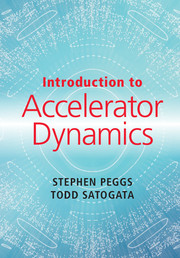Book contents
- Frontmatter
- Dedication
- Contents
- Preface
- 1 Introduction
- 2 Linear Motion
- 3 Strong Focusing Transverse Optics
- 4 Longitudinal and Off-Momentum Motion
- 5 Action and Emittance – One Particle or Many?
- 6 Magnets
- 7 RF Cavities
- 8 Linear Errors and Their Correction
- 9 Sextupoles, Chromaticity and the Hénon Map
- 10 Octupoles, Detuning and Slow Extraction
- 11 Synchrotron Radiation – Classical Damping
- 12 Synchrotron Radiation – Quantum Excitation
- 13 Linacs – Protons and Ions
- 14 Linacs – Electrons
- 15 The Beam–Beam Interaction and 1-D Resonances
- 16 Routes to Chaos
- Appendix A Selected Formulae for Accelerator Design
- References
- Index
2 - Linear Motion
Published online by Cambridge University Press: 08 August 2017
- Frontmatter
- Dedication
- Contents
- Preface
- 1 Introduction
- 2 Linear Motion
- 3 Strong Focusing Transverse Optics
- 4 Longitudinal and Off-Momentum Motion
- 5 Action and Emittance – One Particle or Many?
- 6 Magnets
- 7 RF Cavities
- 8 Linear Errors and Their Correction
- 9 Sextupoles, Chromaticity and the Hénon Map
- 10 Octupoles, Detuning and Slow Extraction
- 11 Synchrotron Radiation – Classical Damping
- 12 Synchrotron Radiation – Quantum Excitation
- 13 Linacs – Protons and Ions
- 14 Linacs – Electrons
- 15 The Beam–Beam Interaction and 1-D Resonances
- 16 Routes to Chaos
- Appendix A Selected Formulae for Accelerator Design
- References
- Index
Summary
The magnets in a circular accelerator are placed in a sequence, or lattice, that is intended to return an ideal test particle, one turn later, to the same location from where it was launched. Usually, this ideal location – the design orbit – is at the centre of the vacuum beampipe, as illustrated in Figure 2.1. It can be shown mathematically that, with static fields (dB/dt = dE/dt = 0), there is one orbit – the closed orbit – that exactly repeats itself, turn after turn. In practice, the design orbit and the closed orbit are not the same, because of the inevitable presence of errors of various sorts, such as magnet misalignments.
Errors, and their correction, are discussed in Chapters 6 and 8. For now, it is assumed that the closed orbit and the design orbit are identical – there are no errors. Even so, it is necessary to consider non-ideal test particles that deviate at least a little from the design orbit. Particles circulate the accelerator in bunches, perhaps 109 per bunch. Their stability must be guaranteed as they oscillate horizontally and vertically, relative to an ideal particle at the centre of a bunch. Figure 2.2 shows the right-handed co-ordinate system that is commonly used to describe such betatron oscillations, with x and y denoting the horizontal and vertical displacements of the test particles, respectively.
Stable Oscillations
The horizontal displacement of a stable particle at a reference point on turn n is written
where a and ϕ0 are the amplitude and the initial phase of the betatron oscillation. The fractional part of the horizontal betatron tune Qx is typically not small in practice – it is 0.155 in the example shown in Figure 2.3 – and the integer part of Qx is usually much greater than 1. An arbitrary integer multiple of 2π can be added to the argument of the sine in Equation 2.1, and so the integer component does not matter when only a single reference point is being considered. This accounting must be done correctly, however, when multiple reference points are used – for example, when considering the linear motion from one reference point to another around a storage ring.
- Type
- Chapter
- Information
- Introduction to Accelerator Dynamics , pp. 13 - 23Publisher: Cambridge University PressPrint publication year: 2017



